PRIMING OF EXPLOSIVES FOR EFFICIENT BLASTING
PRIMING OF EXPLOSIVES FOR EFFICIENT BLASTING:-
PRIMING OF EXPLOSIVES FOR EFFICIENT BLASTING
1. INTRODUCTION:
The massive use of blasting agents such as ANFO, Heavy ANFO etc., in rock breakage has brought about an important development of initiation and priming techniques. This is due to, on one hand, the relative insensitivity of these compounds and, on the other hand, a desire to obtain maximum performance from the energy released by the explosives used in the process.
The detonation process requires initiation energy so that it can develop and majntain stable conditions. The most frequent terminology used in initiation is:
Primer: High strength, sensitive explosive used to initiate the main column in the blasthole. They are cap and detonating cord sensitive, including ones of low core load.
Booster. Powerful explosive charge with no initiation accessory that has two functions:
I. Complete the initiation work of the primer in the explosive column, and
2. Create zones of high energy release along the length of the column.
In the following paragraphs present day knowledge is discussed in order to obtain maximum yield from the explosives.
| Detonation pressure is the pressure in the reaction zone as an explosive detonates.It is a significant indicator of the ability of an explosive to produce good fragmentation.A high detonation pressure is one of the desirable characteristics in a primer |
A blasting agent is an explosive that:Comprises ingredients that by themselves are non-explosive; can only be detonated by a high explosive charge placed within it and not by a detonator.All blasting agents contain the following essential components :
|
2. PRIMER AND BOOSTER:
- Priming a charge is simply positioning a suitable primer within a charge or column of explosives.
- The object is to provide the primary-initiating explosion needed to detonate the main charge efficiently.
- If an explosives column is not initiated properly, its optimum energy cannot be generated.
- A change in the configuration or type of initiation, priming or boosting can lead to a significant increase in blasting efficiency.
- The terms “primer” and “booster” are often confused.
- Primer is a unit of cap-sensitive explosive used to initiate other explosives or blasting agents. A primer contains a detonator or other initiating device such as detonating cord.
- The primer cartridge should be assembled at the work-site.
- The transport of cap primers is hazardous and is against the regulation of most countries.
- Priming should be done correctly by experienced shot-firers.
- The primer cartridge must not be tamped nor dropped into the blasthole.
- When priming blasting agents such as ANFO, the primer should have a diameter which is close to the diameter of the blasthole.
- A booster is a cap-sensitive explosive but does not contain a detonator.
- Its purpose is to maintain or intensify the explosive reaction at a specific point in the explosive charge along a blasthole.
- It is a specially manufactured explosive that can produce a high velocity of detonation (VOD) such as cast boosters that have VOD of 7,600 m/s.
- The most common used boosters are the pentolite boosters.
- A pentolite booster is made up of a mixture pentaerythritol tetranitrate (PETN) and TNT.
| ANFO generates a relatively low detonation pressure, but provides very good heave performance. The steady state VOD of ANFO is approximately 4200ms in 310mm diameter blast holes.The steady state detonating velocity is also a function of loading density. Poured ANFO densities range between 0.78 and 0.85 g/cc while pneumatically loaded ANFO can reach densities up to 0.95 g/cc, consequently achieving higher detonation velocities.ANFO is highly insensitive to mechanical actions (shock, friction, impact).
ANFO should not be placed in conditions where heavy impact or excessive heating may occur as detonation is possible especially if under confinement.
ANFO is desensitised by absorbing moisture.
Every explosive has a certain critical diameter below which detonation will not propagate beyond the primer point.
Confined, ANFO’s critical diameter is approximately 1 1/4 inches.
That is, a borehole or column of ANFO less than two inches in diameter will detonate in the immediate area of the primer, but cannot reliably carry the detonation process much beyond that point.
When ANFO reaches its full VOD the strength is given as:
|
3. PRIMING:
- When an explosive column is initiated at a point, the full steady-state VOD is generally attained some distance away from that point.
- This distance is called the run-up distance.
- The run-up distance varies between explosives.
- ANFO has the maximum (about six charge diameters) and PETN/TNT explosives have the least (about one charge diameter) as in fig – 1.
Fig – 1
- A VOD less than 2,000 m/s is not considered stable.
- Tests carried out by Swedish Detonic Research Foundation (SVEDEFO) showed that a NG based explosives primer cartridge initiates ANFO directly to its full velocity.
- The same result will be obtained with an AN based emulsion explosive primer, provided that its diameter is close to the blasthole diameter.
- Figure 2 shows a primer that has a stable detonation velocity greater than the ANFO stable detonation.
- This will ensure that ANFO will reach its stable velocity in a shorter time and the blasting agent will explode efficiently.
Fig-2
4. PRIMING OF ANFO
- When ANFO is efficiently primed it rapidly reaches its steady state velocity of detonation and maintains it.
- The steady state velocity depends on the density, the confinement and particle size of ANFO as well as the blasthole diameter.
- The VOD increases as the blasthole diameter increases and reaches its highest value at a blasthole diameter of 300 mm.
- The purpose of a primer is to initiate the ANFO so that it rapidly reaches its steady state velocity.
- The primer may initiate the ANFO with low order velocity (VOD lower than the steady state VOD) or overdrive velocity (VOD higher than the steady state VOD).
- Low order initiation is caused by a primer being too small or too low detonation pressure.
Fig – 3
- The velocity distance curve (Figure 3) shows that it takes approximately the length of four blasthole diameters.
- The low energy initiation in the bottom of the blasthole may have serious effect on the blasting result.
- Figure 4 shows how various types and sizes of primers affect the distance from the primer at which ANFO reaches steady state VOD.
Fig – 4
- In general, the closer the primer diameter is to the borehole diameter, the more effective a primer will be in initiating ANFO.
5. TOP VERSUS BOTTOM INITIATION
- In large diameter blastholes in bench mining, an ANFO charge may have a 10 m column, and its VOD of 4 000 m/s.
- If this charge is bottom primed, the stemming and the top part of the burden are not affected by the detonation until 2.5 ms after initiation.
- Thus, the bubble or the gas energy has more time to work near the bottom to move the toe before explosion gases escape through the fractured rock.
- The practice of bottom priming provides a much lower probability of cut-offs, and hence greatly reduce incidence of misfires.
6. QUALITIES OF A PRIMER
- Four properties of primer have a significant influence on its performance.
- Detonation pressure: An effective primer should have a minimum detonation pressure of 5 000 MPa.
Fig – 5
- Diameter: The primer should match the hole diameter as closely as possible; however, its diameter should not be less than 0.67 times the blasthole diameter.
- Length: It should be sufficiently long for maximum VOD to be reached (that is, run-up distance shorter than the primer length).
- Shape: The importance of shape can be seen in Figure 6, which shows the results of a ‘double-pipe tests’.
Fig – 6
7. BOOSTER
- Sometimes, after detonation, a low sensitivity explosive may show signs of losing the VOD progressively along its column.
- This may arise when an ANFO charge is contaminated with water.
- The boosters can be placed at appropriate intervals (about 30 times the blasthole diameter) to increase the VOD along the explosives column.
- Boosters can be placed at appropriate spots where the ground is especially hard and requires extra pressure for satisfactory breakage.
8. SUMMARY
In the priming of ANFO, the efficiency of a primer is defined by its detonation pressure, dimensions and shape. The higher the detonation pressure, the greater its initiating ability.
When priming blasting agents with holes up to 2 1/2 inches in diameter, a full cartridge of high velocity explosives like 60 percent ammonia gelatin, gels, slurries, or cast primers with a blasting cap, is a sufficient charge.
For larger holes, the priming requires much more care, especially if the hole is wet or decked charges are used. A small quantity of a high-velocity primer is better than a large amount of a lower velocity primer. The detonating velocity of the primer must be greater than or equal to the detonating velocity of the agent for efficient detonation.
The best location for priming a charge is at either end of the charge. The placement of primers anywhere else within the powder column shall never be done if there is not also a bottom primer.
With large diameter holes, the shape of the primers, as well as the strength, is important. The diameter of such primers should approach the diameter of the borehole so that the major portion of the available energy is released to propagate a strong detonation wave along the column.
Therefore, the conditions that a primer should comply with in order to eliminate low detonation velocity zones in the ANFO are: the highest possible detonation pressure and a diameter above 213 that of the charge, approximately. The length of the primer is also important, as the primer itself is initiated by a blasting cap or detonating cord and they have a run-up distance in the detonation velocity zone.
The use of detonator cord as a sole detonant is not recommended, since it could cause deflagration rather than detonation of the charge.
The objective of the primer is to achieve a stable detonation. Neither over-priming or underpriming the agent is desirable. The diameter of the primer must be larger than the critical diameter of the explosive.
Every explosive has a certain critical diameter below which detonation will not propagate beyond the primer point. Confined, ANFO’s critical diameter is approximately 1 1/4 inches. That is, a borehole or column of ANFO less than two inches in diameter will detonate in the immediate area of the primer, but cannot reliably carry the detonation process much beyond that point.
The problem of determining how many primers to use and where to locate primers in an explosive column is a difficult one. Too many unnecessary primers add to the cost of blasting, while too few primers rob the blast’s efficiency. Basically, the primers must be located so that the detonation travels through the entire powder column before any of the gas and pressure is vented.
*********************************************************************************
Effect of double-primer placement on fragmentation and rock fracture: The double-primer placement is based on the principle of shock wave collision. When two shock waves meet each other, the final pressure is greater than the sum of the initial two pressures. Stress analysis indicates that this should be favorable to rock fracture and fragmentation in blasting. Double-primer placement was tested successfully in various mines by using electronic detonators, aiming to improve rock fragmentation.
It has been experienced, when two primers are placed at different positions in a blasthole and they are initiated simultaneously, shock-wave collision takes place. In other words, the double-primer placement is based on the principle of shock wave collision. When two shock waves collide each other (head on), the final pressure is greater than the sum of the initial two pressures. Stress analysis indicates that this should be favorable to rock fracture and fragmentation in blasting.
Theory on shock wave collision – According to one-dimensional shock wave theory, when one shock wave with pressure P1 meets another shock with pressure P2, the final shock pressure P3 produced is greater than the sum of the pressures of the initial two shock waves, i.e. P3 > P1+P2. This case is called shock wave collision.
A shock wave collision is different from an elastic wave collision. In one-dimensional condition, as an elastic stress wave with stress σ1 meets with another elastic wave with stress σ2, the final stress σ3 produced is equal to the sum of the stresses of the initial two elastic waves, i.e. σ3 = σ1+σ2. In fact, shock wave is not elastic; thus the resultant intensity of pressure is more than double, hence the benefit of fragmentation.
Generally, in the case of double-primer placement, one primer is placed at the bottom of the borehole and other placed at the middle (not at the collar) of the borehole.
Experiments showed that, the amplitude of stress waves in rock mass due to two-primer placement in a blasthole was much greater than the double of the amplitude of the waves caused by one single primer in a similar blasthole. These experiments indicate potential applications of a two-primer placement in rock blasting.
When electronic detonators came into being, shock collision theory was used to improve fragmentation more precisely.


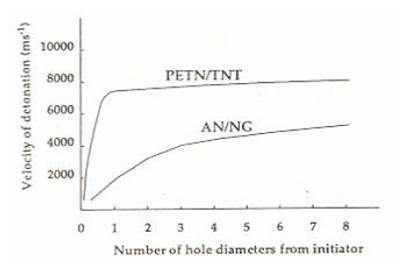
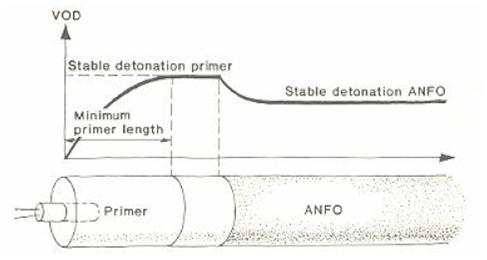
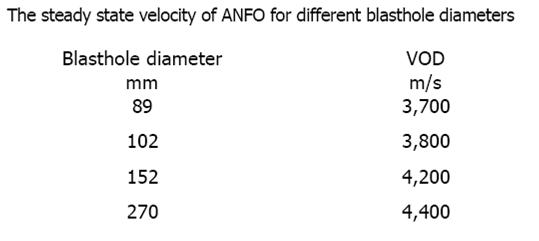
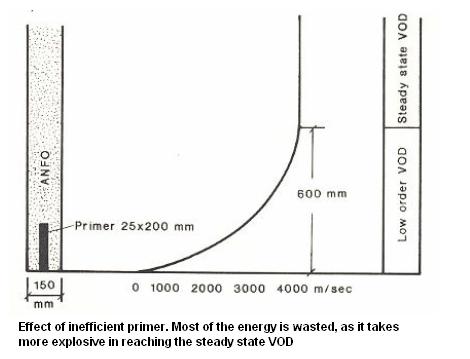
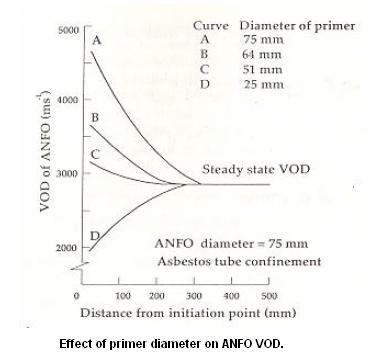
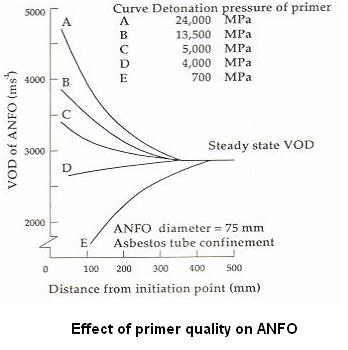
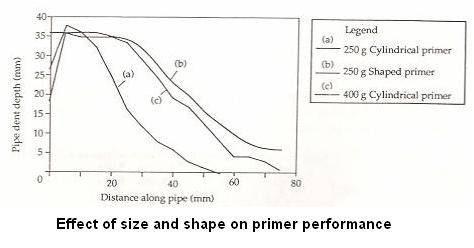



Post a Comment